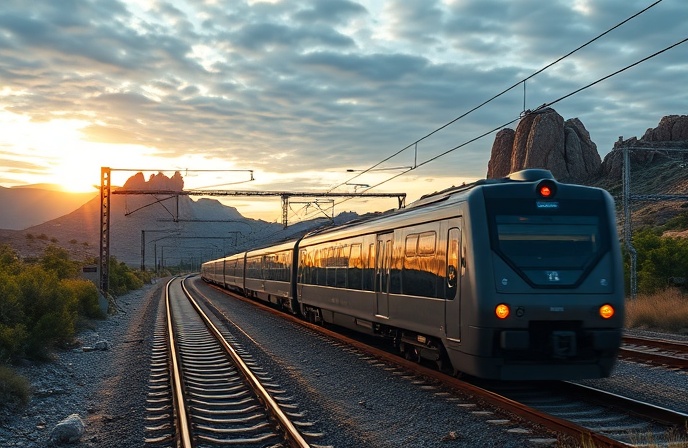China’s High-Speed Rail: Engineering Marvels Across Diverse Terrain

This article explores the recent expansion of China’s high-speed rail network, focusing on two significant new lines: the Zhangjiajie-Jishou-Huaihua line in Hunan province and the Mudanjiang-Jiamusi line in Heilongjiang province. These projects exemplify China’s remarkable capacity to construct and operate high-speed rail (HSR) lines across diverse geographical and climatic conditions, showcasing advancements in railway engineering and technology. The discussion will delve into the specific engineering challenges overcome in each project, the technological solutions implemented to address these challenges, and the broader socio-economic implications of these expansions for the respective regions. Furthermore, the article will briefly touch upon the increasing integration of advanced technologies like centralized train control systems (CTCS) and environmentally conscious practices such as heat recycling HVAC systems within China’s railway infrastructure. The overall impact of these developments on China’s national railway strategy and its global influence will also be considered.
Engineering Marvels in Diverse Terrain: The Hunan Line
The Zhangjiajie-Jishou-Huaihua high-speed railway (HSR) line, spanning 245 kilometers in Hunan province, connects significant tourist destinations and regional centers. Designed for a maximum operating speed of 350 kilometers per hour (km/h), the line presents a testament to overcoming complex geographical challenges. The construction involved the building of 162 bridges and 118 tunnels, accounting for over 90% of the total route length. This highlights the intensive engineering effort required to navigate the mountainous terrain of Hunan. The line’s completion significantly reduces travel time between Zhangjiajie and Huaihua to just one hour and ten minutes, boosting tourism and regional connectivity.
Conquering the Cold: The Heilongjiang Line
In stark contrast to the Hunan line, the Mudanjiang-Jiamusi HSR line in Heilongjiang province showcases China’s ability to build and operate high-speed rail in extremely cold climates. Stretching 372 kilometers across the Changbai Mountains, where temperatures can plummet to -40°C, this line represents a significant feat of engineering. The project required the deployment of cold-resistant power signaling equipment and snow-melting systems to ensure safe and reliable operations in sub-zero conditions. Furthermore, the electric multiple units (EMUs) operating on this line have been specifically modified to withstand the harsh weather conditions, including extreme cold, strong winds, and heavy snowfall. The line, designed for a speed of 250 km/h, reduces the travel time between Mudanjiang and Jiamusi to two hours, dramatically improving regional accessibility.
Technological Advancements and Sustainability
Both projects showcase the integration of advanced technologies within China’s railway infrastructure. The implementation of CTCS (Centralized Train Control System) enhances operational efficiency and safety by providing real-time monitoring and control of train movements. Additionally, the adoption of heat recycling HVAC systems in both projects reflects a commitment to environmental sustainability by improving energy efficiency and reducing the overall carbon footprint of railway operations. These technological advancements demonstrate China’s commitment to building a modern, efficient, and environmentally responsible rail network.
Socio-Economic Impact and Global Implications
The completion of these two high-speed railway lines has significant socio-economic implications for their respective regions. Improved connectivity fosters economic growth by facilitating the movement of goods and people, attracting investments, and stimulating tourism. The reduced travel times significantly enhance accessibility to healthcare, education, and employment opportunities. Furthermore, these projects demonstrate China’s growing expertise in high-speed rail technology and its potential to export this technology and its associated expertise to other countries, as evidenced by the recent inter-governmental agreement with Laos for a cross-border railway service. This highlights China’s expanding influence in global infrastructure development.
Conclusion
The successful completion of the Zhangjiajie-Jishou-Huaihua and Mudanjiang-Jiamusi high-speed railway lines underscores China’s remarkable achievements in railway engineering and its commitment to national infrastructure development. These projects not only demonstrate the country’s ability to overcome diverse geographical and climatic challenges but also showcase the integration of advanced technologies and a focus on environmental sustainability. The significant reduction in travel times and improved connectivity between regional centers have far-reaching socio-economic benefits, stimulating tourism, economic growth, and enhanced access to essential services. The successful execution of these large-scale projects, coupled with the technological advancements integrated within the infrastructure, positions China as a global leader in high-speed rail technology and infrastructure development. The projects demonstrate a sophisticated approach to railway development, encompassing not just the physical construction but also the strategic integration of advanced technologies and consideration for environmental sustainability. Furthermore, the successful implementation of these projects strengthens China’s global presence and its potential to participate in and shape future international infrastructure projects, demonstrating a sophisticated understanding of the interplay between railway development and national economic strategy.




